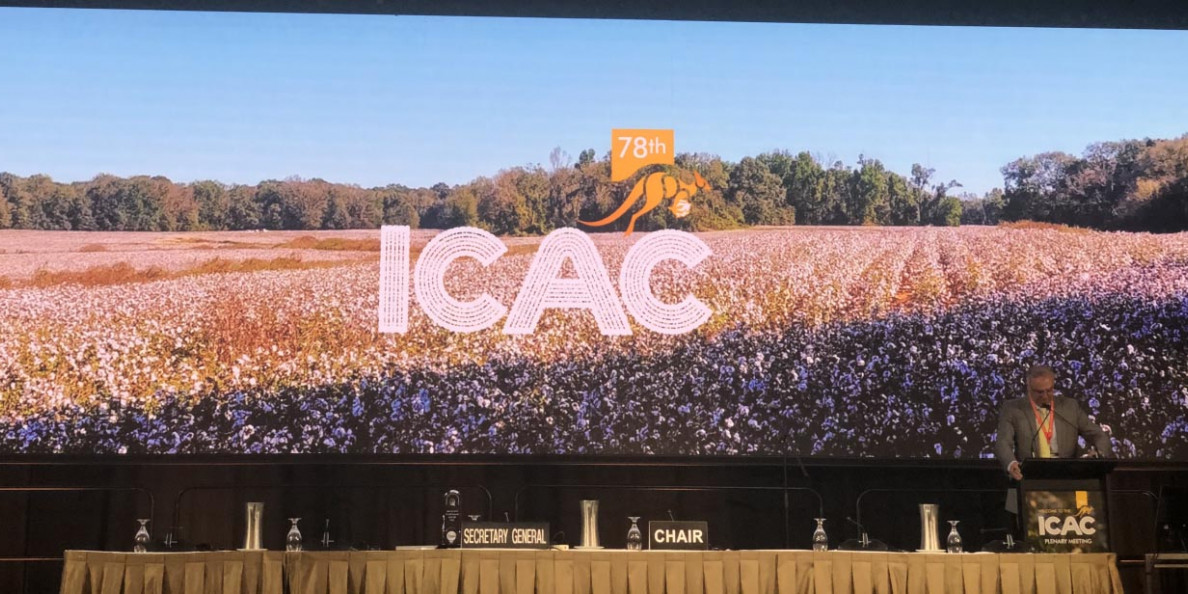Last week representatives from around 30 countries met at the International Cotton Advisory Committee (ICAC) 2019 Plenary Meeting in Brisbane, Australia. The meeting is an opportunity for cotton growers, ginners, traders, textile manufacturers and suppliers to meet and discuss international and domestic issues related to the production and consumption of cotton. One particular learning from last week has stuck in my mind. According to Anupam Gupta from Olam International, cotton is losing its market share from 68% (in 1960) to 27% (expected in 2022) while man-made fibre production is increasing. With such a significant drop, how might cotton re-gain its market share? With this in mind, I have listed three key take away messages from the meeting, and what I see as key opportunity areas for the global cotton and apparel industry. These include widening the range of 100% cotton apparel in womenswear, exploring new ways cotton can value-add in the circular economy, and finally understanding who cares about traceability and why. If you wish to know more, I have written additional notes below.
Takeaway 1. There is a market opportunity for fashion-focused cotton apparel in womenswear
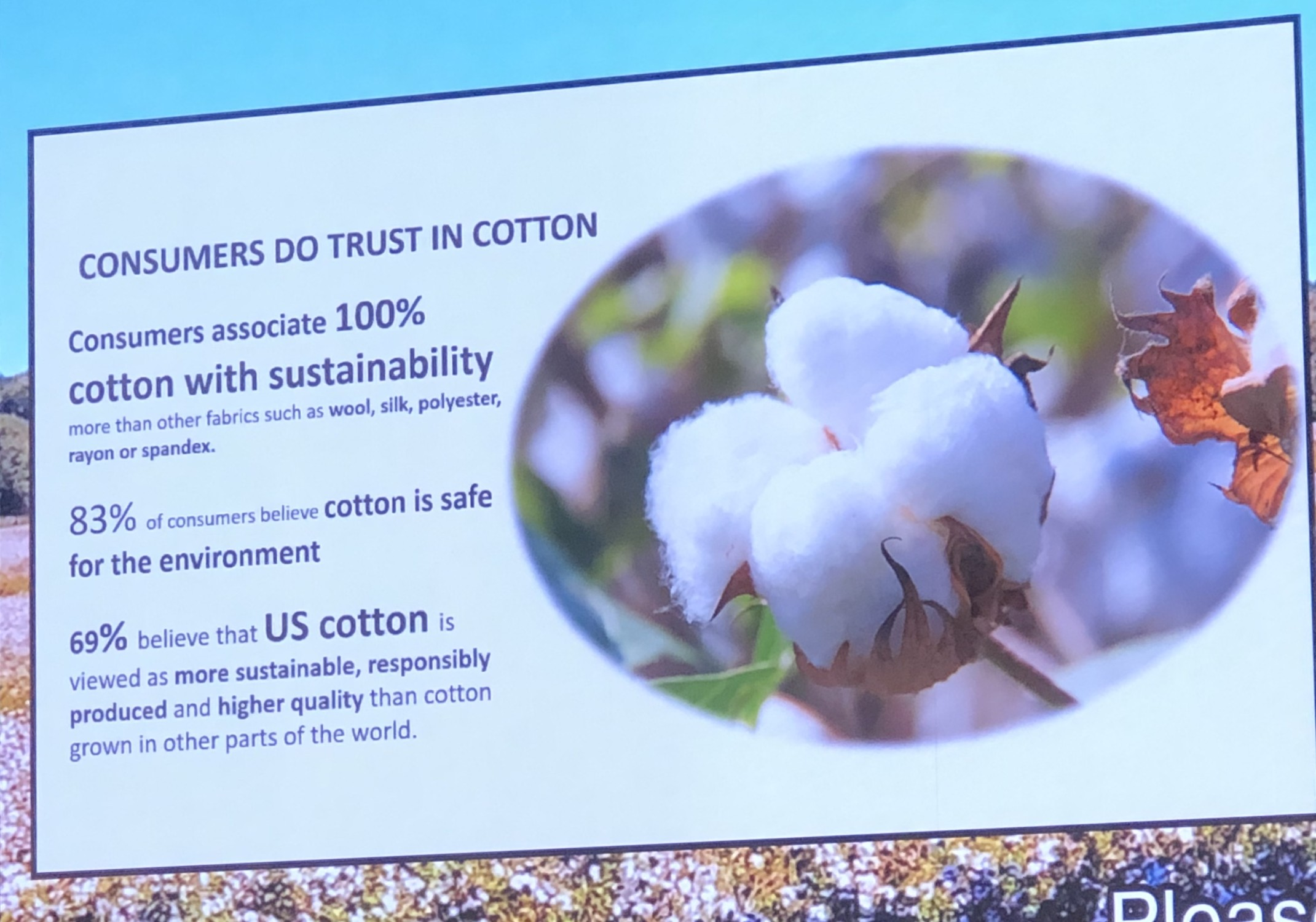
Next time you go shopping, take note of the fibres you come across. What you might notice is a contrast in the availability of fashion-focused cotton apparel between menswear and womenswear. Eimear McDonagh from Namoi Cotton Alliance pointed out you are almost guaranteed to find cotton t-shirts, business shirts, pants and suits in menswear, whereas the majority of garments in womenswear are either synthetic fibres such as polyester or regenerated cellulosic fibres such as rayon. Adding to this, Jannice Cameron-Chapital from Himatsingka, and MeiLin Wan from Applied DNAs (pictured) explained that cotton has a high level of consumer trust and association as a sustainable fibre when compared to other fibres. Tapping into womenswear as a consumer market with 100% cotton fashion pieces is a big market opportunity for the cotton and fashion industry.
Takeaway 2. Cotton is in a prime position for the circular economy, but new ways to value-add to products is needed
Did you know that in an average year around 95 millions tonnes of fibre is produced (Statista 2016) and 92 million tonnes of waste is disposed of (The Pulse of Fashion 2017)? This statistic, shared by Associate Professor Dr Alice Payne from Queensland University of Technology, highlights the sheer amount of wasted resources in fashions’ current linear supply chain with production and disposal at almost parallel quantities. Thea Speechley from RawAssembly also reminded us that only 1% of clothing is currently being recycled. And with retailers making claims around sourcing more recycled polyester as a way towards to a more circular economy, Thea notes this is only a band-aid to the growing problem of increased clothing production, consumption and disposal. Equally problematic is the shedding of microplastics with recycled or virgin polyester, which Richard Venditti from North Carolina State University found that when compared to cotton and rayon, polyester releases more microfibres during washing and takes significantly longer to breakdown when disposed of.
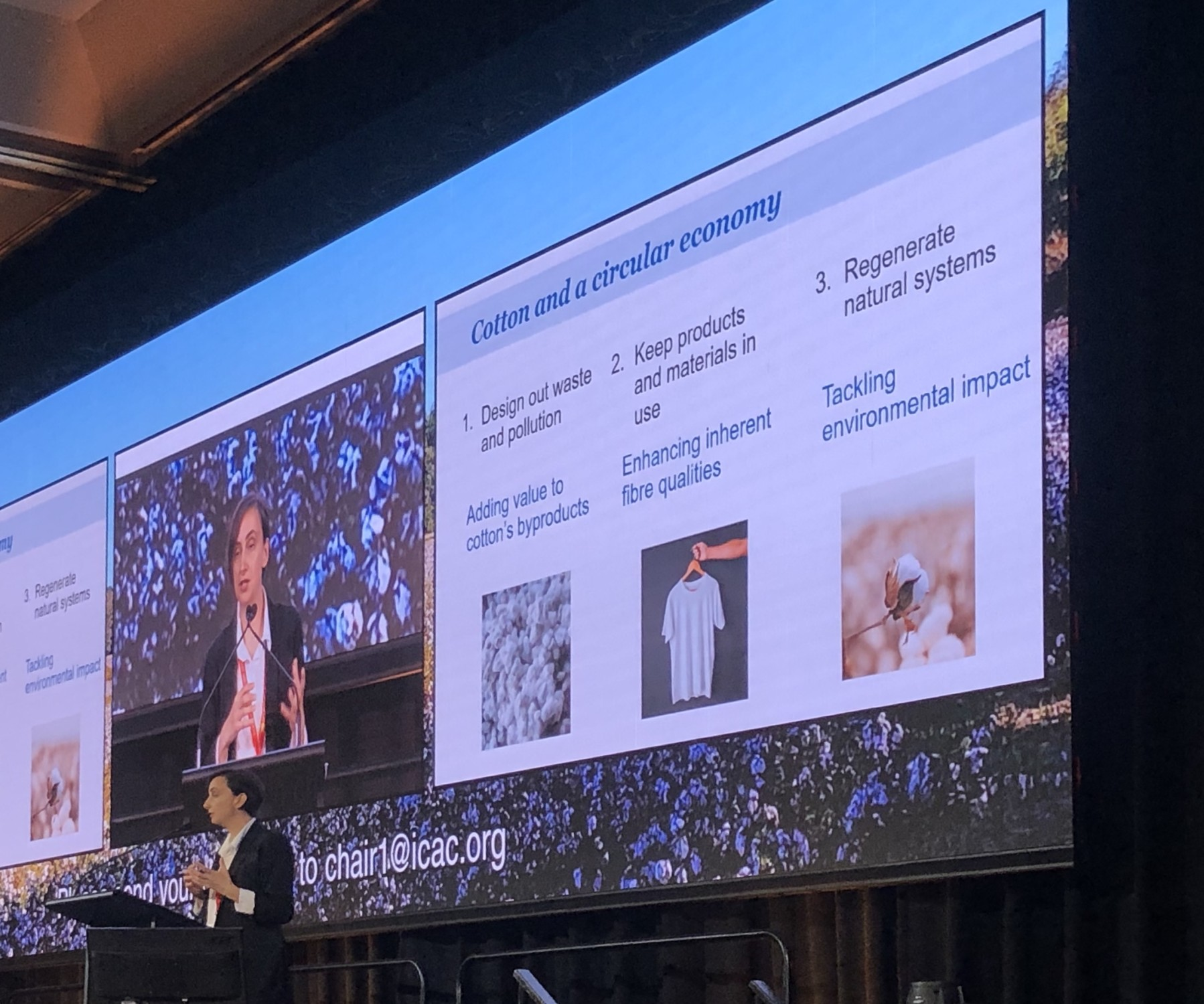
So where are the opportunties for cotton in the circular economy? When it comes to the fibre production level, Alice (pictured) said there are clear pathways to ensure that all of the cotton plant is not wasted, such as turning cotton seed into cattle feed or consumables such as oil and soap. As fashion moves towards a more circular economy, Alice said the opportunities for cotton lie in the fibres inherently ability to biodegrade and be composted. Timely opportunities which the cotton industry can capitalise upon include exploring pathways for recycling post-consumer textiles, especially as more brands implement take-back schemes. Related to this is the need for the industry to find new ways to value-add to products in the circular economy, for example recycled cotton still needs virgin cotton fibre for strength. Lastly, Alice noted there was a gap in considering the social benefits of a circular economy. And with cotton providing income for many millions of people worldwide there is an opportunity to move the needle and include a social dimension into circular economy discourse and actions.
Takeaway 3. Traceability is an ongoing conversation, but why do consumers and retailers want traceability?
Tracing cotton is difficult, for example spinners may have to blend many different types of cotton, sometimes with synthetic fibres such as polyester, to meet yarn specification. The first two open sessions on Day One of the ICAC meeting delved into traceability (session two panel pictured below). Moderated by Allan Williams from Cotton Research and Development Corporation (CRDC) (pictured in the middle), we got to hear from three traceability solutions providers, including (from left to right)
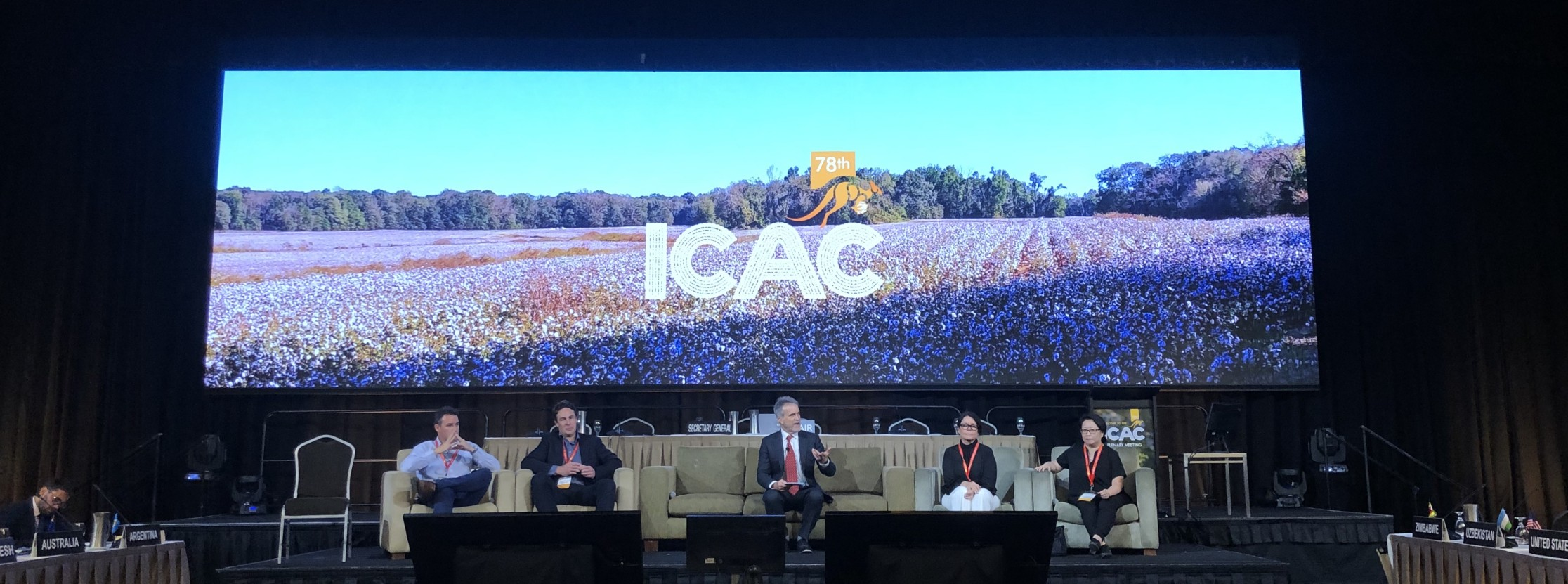
- FibreTrace which applies rare earth minerals onto the fibre which can then be tracked through the supply chain using Blockchain technology. Environmental and ethical data at each stage can also be collected through the platform, and there is also a consumer-facing competent which shows the journey of a product from start to finish through augmented reality (presented by Shannon Mercer);
- Oritan which uses forensic technology to identify fibre origin (presented by Sandon Adams); and
- the CertainT™ platform which tags, tracks and tests raw materials and products with a molecular identifier (presented by Jannice Cameron-Chapital from Himatsingka, and MeiLin Wan from Applied DNAs).
We heard from Allan McClay about the Better Cotton Initiative (BCI) and the pros and cons of a mass balance system. BCI is a sustainable cotton identity program which you might have seen at Australia retailers such as Kmart, Target and Country Road, but also at global brands such as IKEA and Levis? Mass balance means that cotton is not physical tracked all the way through the supply chain, rather cotton is physically tracked to the gin (the stage before it is spun into yarn) where it receives a Better Cotton Claim Unit (BCCU) which is then sourced by supply chain members and retailers (pictured). In other words, the cotton and credits are separated, and traders and retailers buy the BCCU credits rather than the physical cotton. Allan said that BCI has reached scale (currently 19% of global cotton is BCI) because of the affordability of mass balance compared to physical traceability.
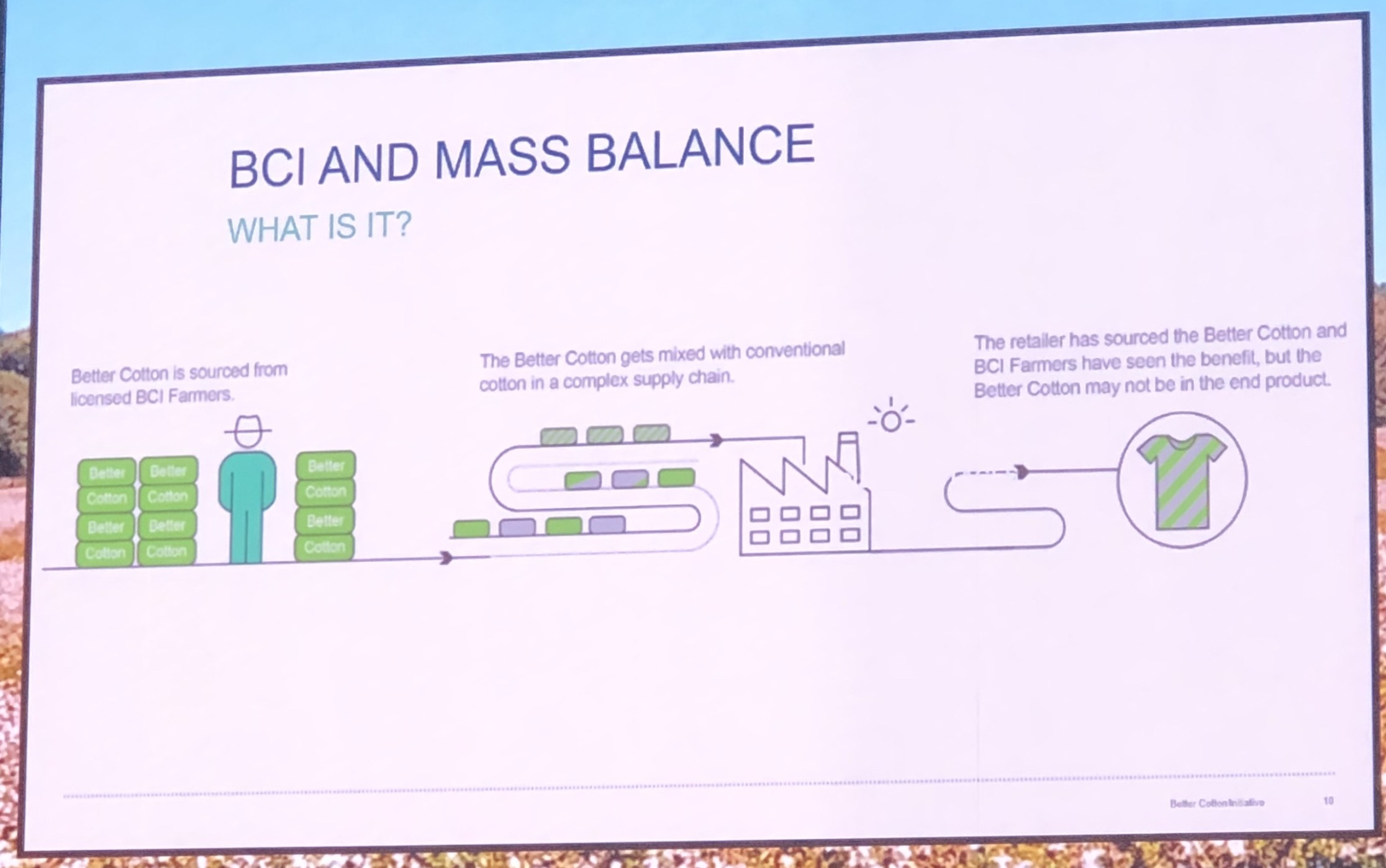
Overall, we learned that there is an added cost with traceability, and the more traceable the supply chain the more it will cost. So rather than a take away message here, I have a take away question: why do consumers and retailers want traceability?
Arthur Spellson from Auscott said there are different reasons for why retailers engage with traceability – some are looking to differentiate themselves in the market place, and others are trying to protect their reputation or manage risks such as forced or child labour issues. However, when it comes to the consumer, Allan from CRDC noted that there is minimal research on what consumers are looking for in regards to traceability. Adding to this, Allan said that brands and retailers that will survive will be those that best engage with the consumers.
So moving forward, one question we need to ask and understand is what are consumers looking for when they say they want traceability? And from this, what are the opportunities for cotton?
Disclaimer: Zoe Mellick is currently undertaking a sustainable value chain analysis on the Australian cotton industry at Queensland University of Technology. The PhD study is co-funded by the Cotton Research and Development Corporation and the Australian Government’s Research Training Stipend. Views in this article are my own and information has been sourced from speakers’ presentations which are all publicly available here https://icacaustralia2019.com/agenda/

